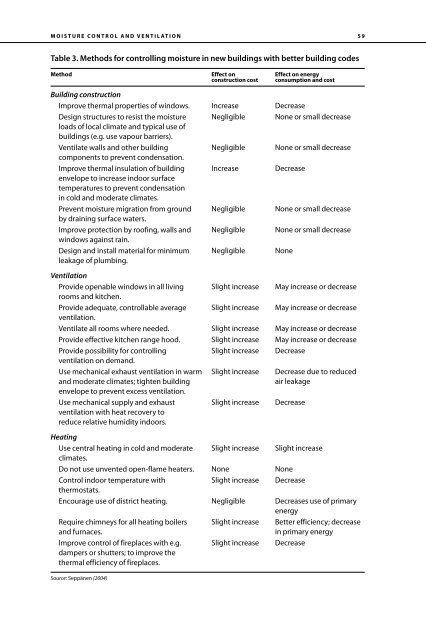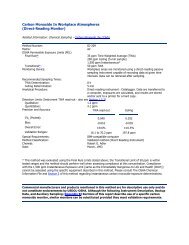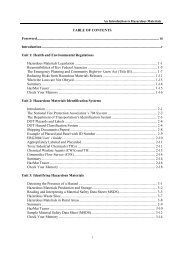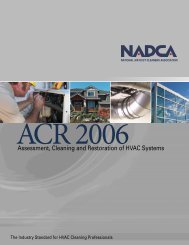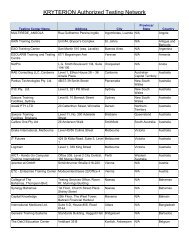Dampness and Mould - WHO guidelines for indoor air quality - PRWeb
Dampness and Mould - WHO guidelines for indoor air quality - PRWeb
Dampness and Mould - WHO guidelines for indoor air quality - PRWeb
Create successful ePaper yourself
Turn your PDF publications into a flip-book with our unique Google optimized e-Paper software.
MOISTURE CONTROL AND VENTILATION<br />
59<br />
Table 3. Methods <strong>for</strong> controlling moisture in new buildings with better building codes<br />
Method<br />
Building construction<br />
Improve thermal properties of windows.<br />
Design structures to resist the moisture<br />
loads of local climate <strong>and</strong> typical use of<br />
buildings (e.g. use vapour barriers).<br />
Ventilate walls <strong>and</strong> other building<br />
components to prevent condensation.<br />
Improve thermal insulation of building<br />
envelope to increase <strong>indoor</strong> surface<br />
temperatures to prevent condensation<br />
in cold <strong>and</strong> moderate climates.<br />
Prevent moisture migration from ground<br />
by draining surface waters.<br />
Improve protection by roofing, walls <strong>and</strong><br />
windows against rain.<br />
Design <strong>and</strong> install material <strong>for</strong> minimum<br />
leakage of plumbing.<br />
Ventilation<br />
Provide openable windows in all living<br />
rooms <strong>and</strong> kitchen.<br />
Provide adequate, controllable average<br />
ventilation.<br />
Ventilate all rooms where needed.<br />
Provide effective kitchen range hood.<br />
Provide possibility <strong>for</strong> controlling<br />
ventilation on dem<strong>and</strong>.<br />
Use mechanical exhaust ventilation in warm<br />
<strong>and</strong> moderate climates; tighten building<br />
envelope to prevent excess ventilation.<br />
Use mechanical supply <strong>and</strong> exhaust<br />
ventilation with heat recovery to<br />
reduce relative humidity <strong>indoor</strong>s.<br />
Heating<br />
Use central heating in cold <strong>and</strong> moderate<br />
climates.<br />
Do not use unvented open-flame heaters.<br />
Control <strong>indoor</strong> temperature with<br />
thermostats.<br />
Encourage use of district heating.<br />
Require chimneys <strong>for</strong> all heating boilers<br />
<strong>and</strong> furnaces.<br />
Improve control of fireplaces with e.g.<br />
dampers or shutters; to improve the<br />
thermal efficiency of fireplaces.<br />
Source: Seppänen (2004)<br />
Effect on<br />
construction cost<br />
Increase<br />
Negligible<br />
Negligible<br />
Increase<br />
Negligible<br />
Negligible<br />
Negligible<br />
Slight increase<br />
Slight increase<br />
Slight increase<br />
Slight increase<br />
Slight increase<br />
Slight increase<br />
Slight increase<br />
Slight increase<br />
None<br />
Slight increase<br />
Negligible<br />
Slight increase<br />
Slight increase<br />
Effect on energy<br />
consumption <strong>and</strong> cost<br />
Decrease<br />
None or small decrease<br />
None or small decrease<br />
Decrease<br />
None or small decrease<br />
None or small decrease<br />
None<br />
May increase or decrease<br />
May increase or decrease<br />
May increase or decrease<br />
May increase or decrease<br />
Decrease<br />
Decrease due to reduced<br />
<strong>air</strong> leakage<br />
Decrease<br />
Slight increase<br />
None<br />
Decrease<br />
Decreases use of primary<br />
energy<br />
Better efficiency; decrease<br />
in primary energy<br />
Decrease


